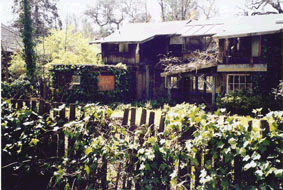On June 24, 1905 Elizabeth Barber deeded Lot 5 to Lillian O’Hara and Grace G. Livermore. Lot 4, deeded by Elizabeth to E. W. A. Waterhouse and by Waterhouse to his mother-in-law, Magadelena Van Winkle, in 1904, was transferred to Lillian and Grace on April 4, 1906.
Lillian (Tish) O’Hara was born in Ontario, Canada April 24, 1864. Her father, an Irish-born bookseller, died when she was 10 years old. She attended art school in Canada and came with her widowed mother, Mary E. O’Hara, to Independence, California in the 1880s and then to San Francisco prior to 1900. She exhibited at the California Midwinter International Exposition of 1894 in Golden Gate Park. She, with Grace G. Livermore, founded the interior decorating firm of O’Hara & Livermore.
Grace was born August 3, 1865 in Fremont, Wisconsin. After her father’s death in 1874, she came with her mother, Susan Homer Livermore, and brothers and lived with her mother’s brother and sister in San Francisco. Grace studied art and became an artist (portraits and floral still lives) and a teacher of painting. She exhibited at the San Francisco Academy of Arts in 1885.
The Sutter Street firm of O’Hara & Livermore, the largest and perhaps the first interior design studio in San Francisco, was destroyed by the 1906 earthquake and fire. The business reopened later and many of San Francisco’s interior decorators got their start working for the firm.
Lillian O’Hara and Grace Livermore were friends with many of the artists and architects of the day, including Julia Morgan and metalworker Lillian Palmer. Miss O’Hara was a small woman, bent over as a result of a childhood accident in which she fell off the porch of the family home in Canada. She walked with the aid of handmade sticks with silver knobs which, as with most everything, were custom made. All of her clothes were custom made and decorated with embroidery. The neighborhood children thought she was a bit frightening. She was, perhaps, a little feisty and somewhat eccentric, but she was a brilliant and shrewd businesswoman. Because of her small and disabled appearance, businessmen tended not to take her seriously at first. They learned though that she was someone to be dealt with. Although many of her friends were male, besting a man in a business deal gave her a smug pleasure.
She and Grace had several summer Craftsman-style cottages built between Barber Avenue and the creek and rented them out only to their friends or people they personally approved of. Each of the houses had beautiful gardens, designed and supervised by Miss O’Hara. The 1928 Assessor’s Record and the 1924 Sanborn Map show five cottages on Barber Avenue owned by O’Hara and Livermore, two dating from about 1910-1912 and the others to the early 1920s. Miss O’Hara had a home built for herself at 48 Barber – everything small – built to HER scale (it may have been designed by San Anselmo architect, Harris Osborn). Even the furniture had short legs. On March 31, 2003, the house, vacant and in a bad state of disrepair, was demolished.

O’Hara House in 2003. A workman removing redwood planks was unable to stand at full height in the upstairs rooms.
Grace retired in 1922 and died of a stroke at her home in Barber Tract on July 16, 1927. Lillian died November 18, 1959 at the age of 96. In her obituary Lillian was described as an innovator whose ideas were far ahead of her time. She was “credited with the first use of redwood for interior decoration and for furniture” and the use of “a central fireplace that heated two rooms and adjoining windows at every corner of the house.” Lillian’s San Anselmo property was inherited by a relative, Winifred Copp. The Copp family owned the property until 2002.
On April 12, 1907 Lillian O’Hara and Grace Livermore deeded the southern portion of Lot 4 to John B. Curtis. John Curtis, a recent widower, was an insurance agent. The house at 114 Barber, still standing, was built (possibly designed by Harris Osborn) for John Curtis and his daughter Agnes and son-in-law Frederick Wight, a salesman for the U.S. Steel Company. Agnes and Frederick had one daughter, Luetta, born in 1897. Luetta is listed in the 1920 census as a public school teacher. Agnes died in July 1913 after a long struggle with tuberculosis. Frederick married Mary V. Sanford about 1915. The Wights owned the property for many years; it was later owned by the Gaustavino family.

O’Hara House in 2003. Craftsman detailing still evident

